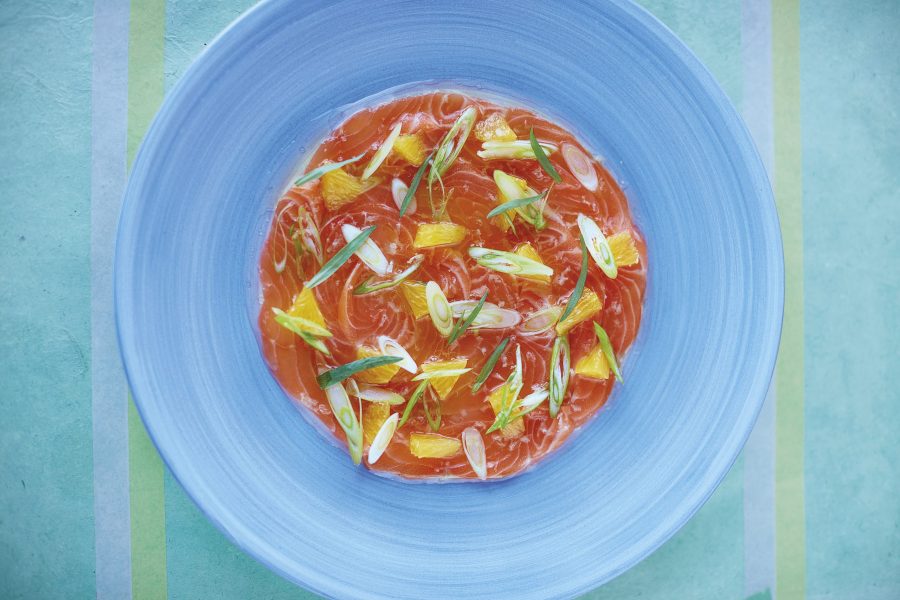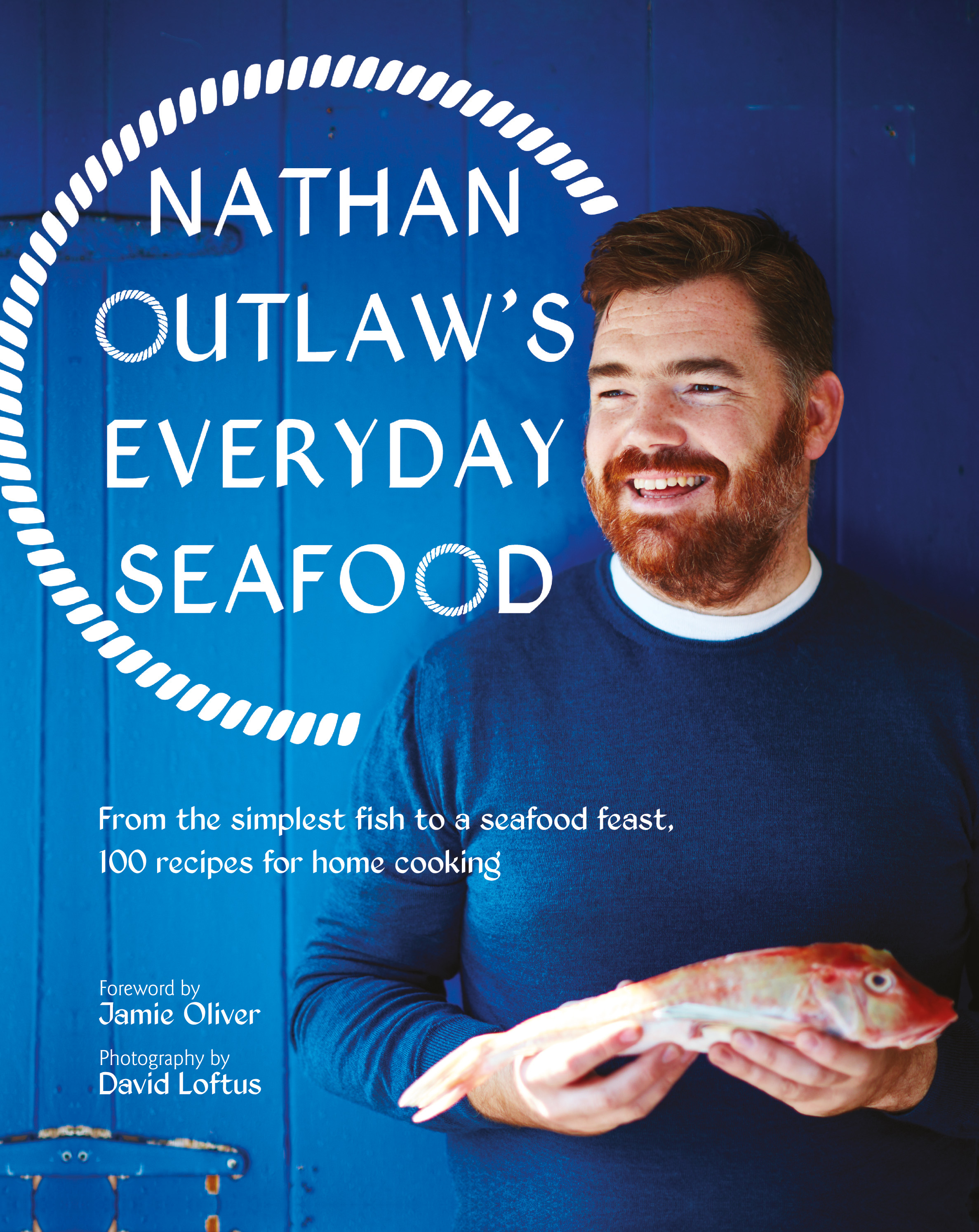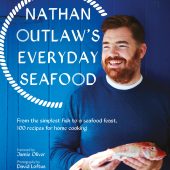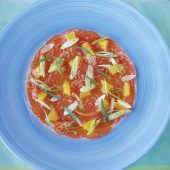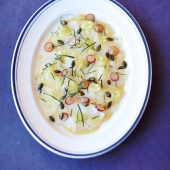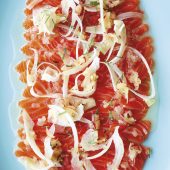Nathan Outlaw’s Everyday Seafood offers some quirky raw recipes using some of Britain’s favourite fish. Words: Nathan Outlaw. Photographs: David Loftus
RAW SALMON WITH VODKA, ORANGE AND HORSERADISH
Serves 4 as a starter
This dish is really quick and fun to make. You can even let your guests do it for themselves if you want! The most important thing is to get hold of some super fresh salmon. I use organically farmed Lock Duart salmon, for me it works perfectly in the raw and cured salmon dishes I serve.
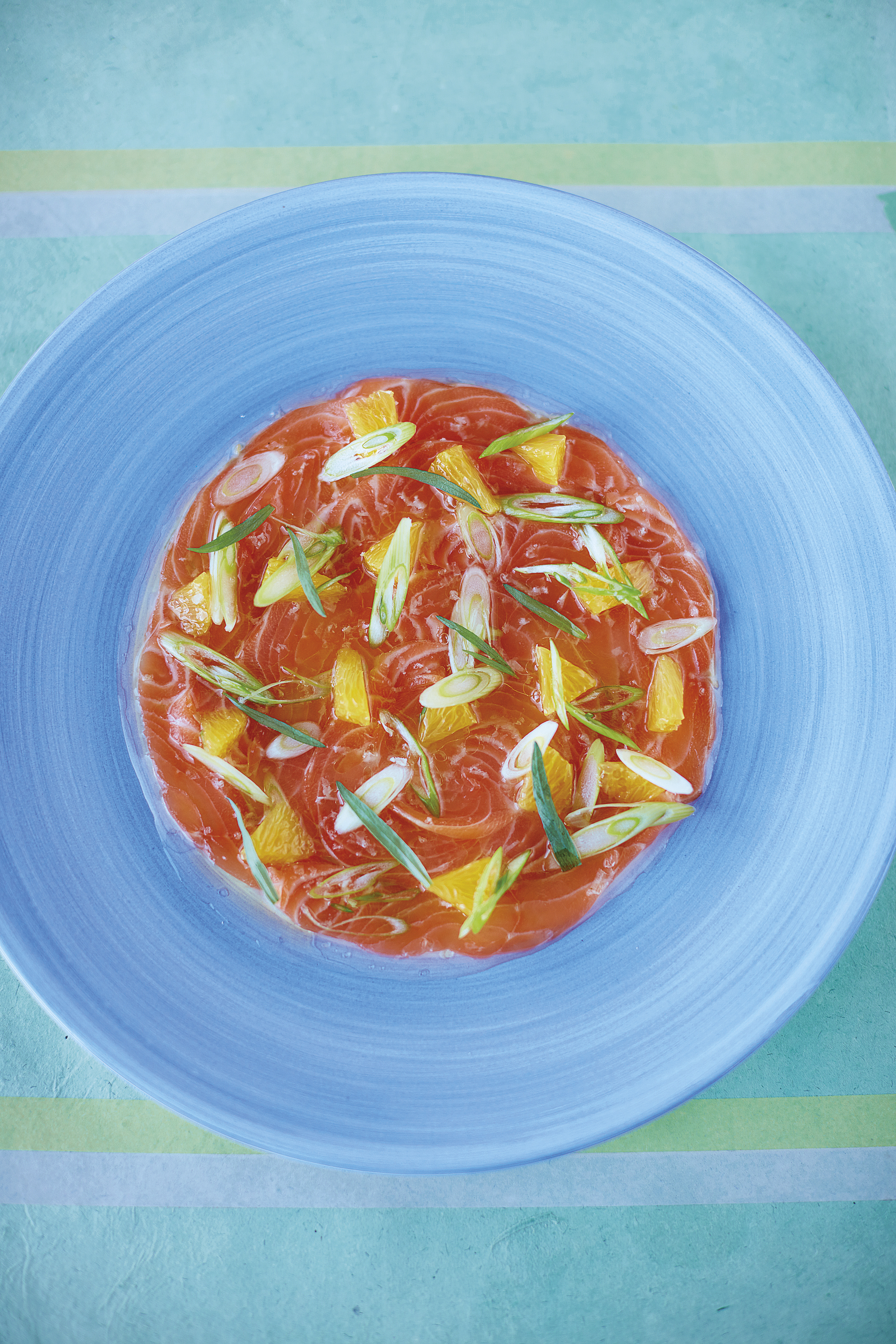
INGREDIENTS:
400g very fresh salmon fillet, skinned
1 orange
1 bunch of spring onions, trimmed and finely sliced on the diagonal
2 tbsp freshly grated horseradish
6–8 tbsp lemon vodka
8 tbsp olive oil
Sea salt
Tarragon leaves, to finish
METHOD:
Chill 4 flat serving plates in the fridge. Cut away the peel and pith from the orange, then cut out the segments from between the membranes. Cut the orange flesh into small dice.
Using a very sharp knife and a clean board, slice the salmon thinly (or dice it into small pieces if you find it easier).
Lay the slices of salmon on the chilled plates. Sprinkle with a little salt, then scatter over the spring onions, orange and horseradish.
Mix together the vodka and olive oil and spoon over the salmon equally. Garnish with tarragon leaves and eat immediately.
VERJUS-CURED MONKFISH WITH PUMPKIN SEEDS AND GRAPE DRESSING
Serves 4 as a starter
Verjus is a natural grape product that we use in various ways in our kitchens. It isn’t something you would associate with curing fish but I was determined to give it a try and after a few efforts I came up with this recipe. I think the simplicity of this dish is beautiful. The texture of the pumpkin seeds and grapes works so well with the soft cured monkfish.
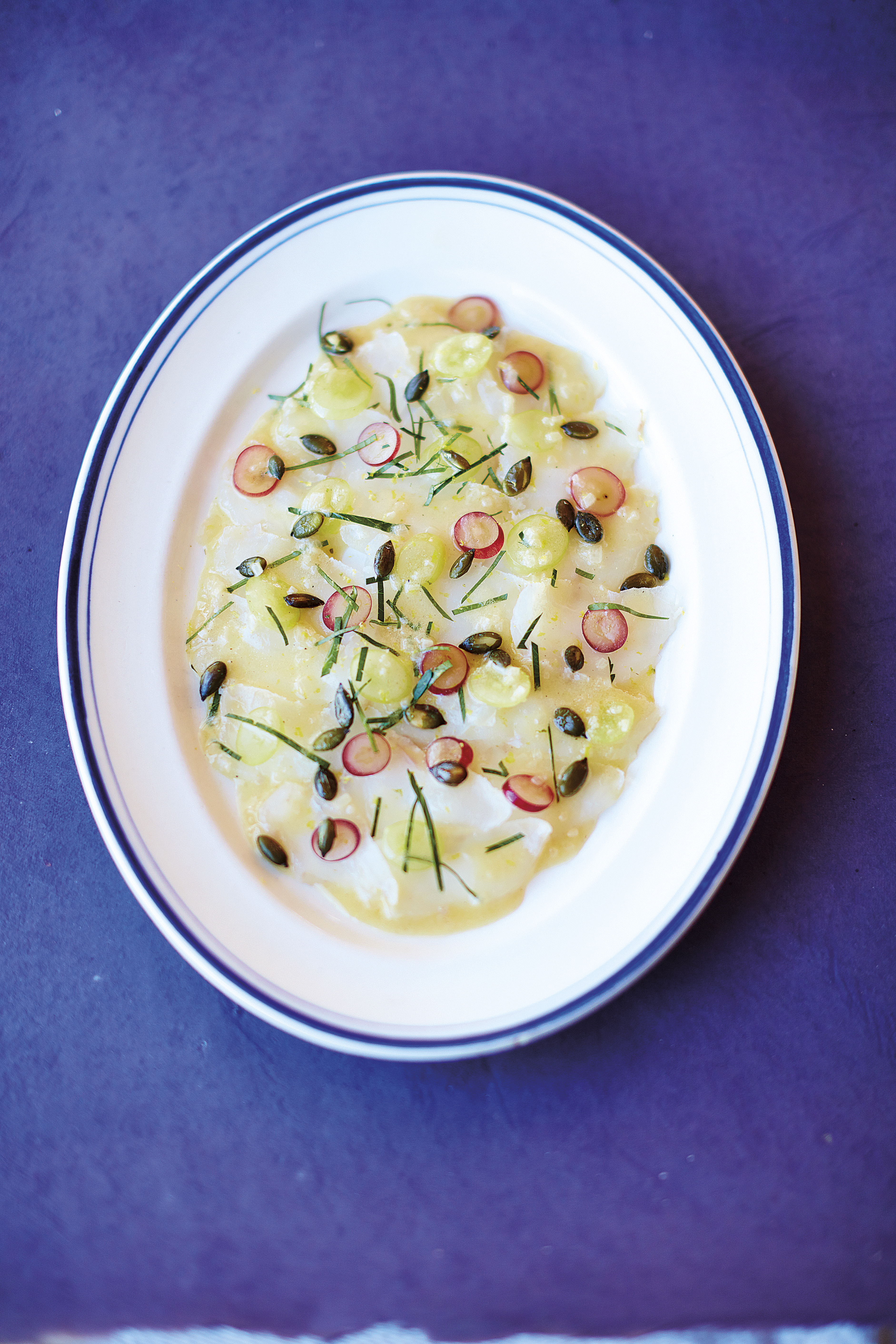
INGREDIENTS:
800g very fresh monkfish fillet, skinned and trimmed
FOR THE CURE
200g sea salt
100g caster sugar
100ml verjus
2 tbsp rosemary leaves
FOR THE DRESSING
2 shallots, peeled and finely chopped
100ml verjus
2 tsp Dijon mustard
100ml olive oil
10 green seedless grapes, sliced
10 red seedless grapes, sliced
Sea salt
FOR THE GARNISH
150g pumpkin seeds
400ml sunflower oil, for frying
Finely grated zest of 1 lemon
2 tsp finely sliced flat-leaf parsley leaves
METHOD:
For the cure, put the salt, sugar and rosemary into a food processor and blitz for 3 minutes.
Lay the monkfish on a tray and sprinkle evenly with the salt mixture. Turn the fish over a few times to ensure it is coated all over. Drizzle the verjus evenly over the fish, then wrap the whole tray in cling film and place in the fridge to cure for 3 hours.
When the time is up, unwrap the fish and wash off the cure with cold water, then pat dry with kitchen paper. Wrap the fish tightly in fresh cling film and place back in the fridge for an hour to firm up. (At this stage you can freeze the fish for up to a month).
To prepare the pumpkin seed garnish, put the oil and pumpkin seeds into a small pan and heat slowly over a medium heat until the seeds begin to puff up. As soon as they start to pop, carefully take the pan off the heat. Using a slotted spoon, remove the seeds from the oil and drain them on a tray lined with kitchen paper. Season with salt and allow to cool.
To make the dressing, put the shallots and verjus into a small pan, bring to the boil and then tip the contents of the pan into a bowl. Add the mustard and whisk to combine. Now add the olive oil in a slow, steady stream, whisking all the time. Season with salt to taste and add the sliced grapes.
Using a sharp knife and a clean board, slice the monkfish as thinly as possible and lay it equally on 4 plates. Spoon the dressing over the fish, sharing the grapes evenly. Scatter over the lemon zest, parsley and pumpkin seeds, then serve.
GIN-CURED SEA TROUT WITH APPLE AND FENNEL
Serves 6 as a starter
Wild sea trout is, for me, a delicacy. I actually prefer it to salmon and find that it responds particularly well to curing. Using strong alcohol in the cure helps to achieve a pronounced flavour and the combination of gin, apple and fennel works so well here. This is a good dish for a party because it can be prepared in advance and whipped out of the fridge when you’re ready to serve.
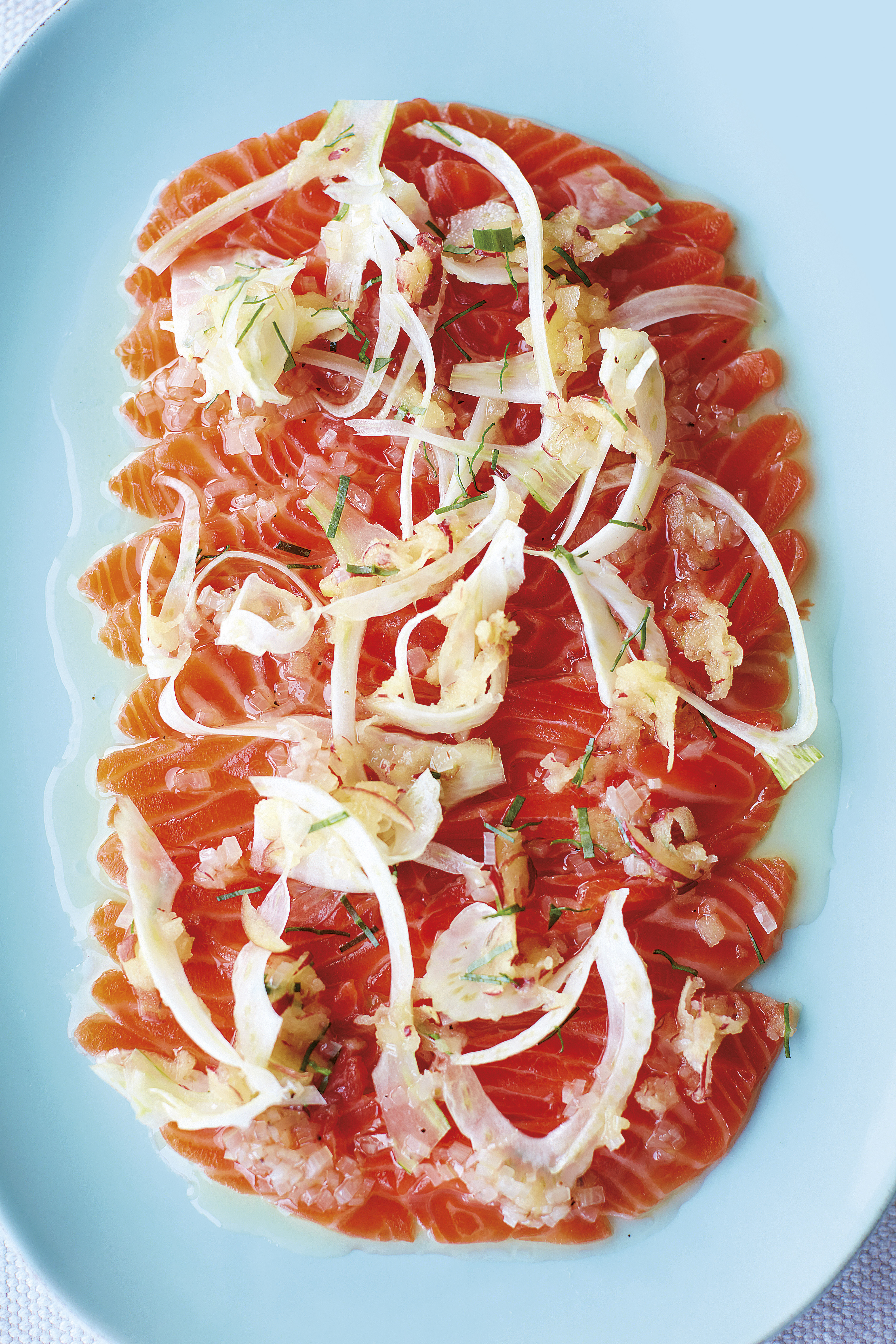
INGREDIENTS:
1 very fresh side of wild sea trout, skinned and pin- boned
FOR THE CURE
250g sea salt
250g caster sugar
2 tbsp juniper berries, crushed
150ml gin
FOR THE SALAD AND DRESSING
200ml olive oil
2 shallots, peeled and finely sliced
4 juniper berries, finely chopped
100ml cider vinegar
30ml gin
2 fennel bulbs, tough outer layer removed
3 eating apples, such as Braeburn
3 tsp finely sliced tarragon
METHOD:
For the cure, put the salt, sugar and crushed juniper berries into a food processor and blitz for 3 minutes.
Lay the sea trout on a tray and sprinkle evenly with the cure mixture. Turn the fish over in the cure a few times to ensure it is coated all over. Drizzle the gin evenly over the fish, then wrap the whole tray in cling film and place in the fridge to cure for 4 hours.
When the time is up, unwrap the fish and wash off the cure with cold water, then pat dry with kitchen paper. Wrap the fish tightly in fresh cling film and place back in the fridge for an hour to firm up. (At this stage you can freeze the fish for up to a month).
To make the dressing, put the olive oil, shallots and chopped juniper berries in a small pan over a medium heat until the oil just begins to bubble. Take the pan off the heat and add the cider vinegar and gin.
Slice the fennel on a mandoline as thinly as possible and place it in a bowl. Peel, core and grate the apples, then add to the fennel with the tarragon. Toss to combine and dress the salad with half of the dressing, keeping the rest to finish the dish.
Using a sharp knife and a clean board, slice the trout as thinly as possible. Lay it out on large individual plates and drizzle with the remaining dressing. Bring to room temperature before serving.
Nathan Outlaw's Everyday Seafood (Quadrille, £20). Photography by David Loftus. For more recipes and food and drink stories click here or pick up a copy of the magazine.
Nathan Outlaw’s Everyday Seafood offers some quirky raw recipes using some of Britain’s favourite fish. Words: Nathan Outlaw. Photographs: David Loftus
RAW SALMON WITH VODKA, ORANGE AND HORSERADISH
Serves 4 as a starter
This dish is really quick and fun to make. You can even let your guests do it for themselves if you want! The most important thing is to get hold of some super fresh salmon. I use organically farmed Lock Duart salmon, for me it works perfectly in the raw and cured salmon dishes I serve.

INGREDIENTS:
400g very fresh salmon fillet, skinned
1 orange
1 bunch of spring onions, trimmed and finely sliced on the diagonal
2 tbsp freshly grated horseradish
6–8 tbsp lemon vodka
8 tbsp olive oil
Sea salt
Tarragon leaves, to finish
METHOD:
Chill 4 flat serving plates in the fridge. Cut away the peel and pith from the orange, then cut out the segments from between the membranes. Cut the orange flesh into small dice.
Using a very sharp knife and a clean board, slice the salmon thinly (or dice it into small pieces if you find it easier).
Lay the slices of salmon on the chilled plates. Sprinkle with a little salt, then scatter over the spring onions, orange and horseradish.
Mix together the vodka and olive oil and spoon over the salmon equally. Garnish with tarragon leaves and eat immediately.
VERJUS-CURED MONKFISH WITH PUMPKIN SEEDS AND GRAPE DRESSING
Serves 4 as a starter
Verjus is a natural grape product that we use in various ways in our kitchens. It isn’t something you would associate with curing fish but I was determined to give it a try and after a few efforts I came up with this recipe. I think the simplicity of this dish is beautiful. The texture of the pumpkin seeds and grapes works so well with the soft cured monkfish.

INGREDIENTS:
800g very fresh monkfish fillet, skinned and trimmed
FOR THE CURE
200g sea salt
100g caster sugar
100ml verjus
2 tbsp rosemary leaves
FOR THE DRESSING
2 shallots, peeled and finely chopped
100ml verjus
2 tsp Dijon mustard
100ml olive oil
10 green seedless grapes, sliced
10 red seedless grapes, sliced
Sea salt
FOR THE GARNISH
150g pumpkin seeds
400ml sunflower oil, for frying
Finely grated zest of 1 lemon
2 tsp finely sliced flat-leaf parsley leaves
METHOD:
For the cure, put the salt, sugar and rosemary into a food processor and blitz for 3 minutes.
Lay the monkfish on a tray and sprinkle evenly with the salt mixture. Turn the fish over a few times to ensure it is coated all over. Drizzle the verjus evenly over the fish, then wrap the whole tray in cling film and place in the fridge to cure for 3 hours.
When the time is up, unwrap the fish and wash off the cure with cold water, then pat dry with kitchen paper. Wrap the fish tightly in fresh cling film and place back in the fridge for an hour to firm up. (At this stage you can freeze the fish for up to a month).
To prepare the pumpkin seed garnish, put the oil and pumpkin seeds into a small pan and heat slowly over a medium heat until the seeds begin to puff up. As soon as they start to pop, carefully take the pan off the heat. Using a slotted spoon, remove the seeds from the oil and drain them on a tray lined with kitchen paper. Season with salt and allow to cool.
To make the dressing, put the shallots and verjus into a small pan, bring to the boil and then tip the contents of the pan into a bowl. Add the mustard and whisk to combine. Now add the olive oil in a slow, steady stream, whisking all the time. Season with salt to taste and add the sliced grapes.
Using a sharp knife and a clean board, slice the monkfish as thinly as possible and lay it equally on 4 plates. Spoon the dressing over the fish, sharing the grapes evenly. Scatter over the lemon zest, parsley and pumpkin seeds, then serve.
GIN-CURED SEA TROUT WITH APPLE AND FENNEL
Serves 6 as a starter
Wild sea trout is, for me, a delicacy. I actually prefer it to salmon and find that it responds particularly well to curing. Using strong alcohol in the cure helps to achieve a pronounced flavour and the combination of gin, apple and fennel works so well here. This is a good dish for a party because it can be prepared in advance and whipped out of the fridge when you’re ready to serve.

INGREDIENTS:
1 very fresh side of wild sea trout, skinned and pin- boned
FOR THE CURE
250g sea salt
250g caster sugar
2 tbsp juniper berries, crushed
150ml gin
FOR THE SALAD AND DRESSING
200ml olive oil
2 shallots, peeled and finely sliced
4 juniper berries, finely chopped
100ml cider vinegar
30ml gin
2 fennel bulbs, tough outer layer removed
3 eating apples, such as Braeburn
3 tsp finely sliced tarragon
METHOD:
For the cure, put the salt, sugar and crushed juniper berries into a food processor and blitz for 3 minutes.
Lay the sea trout on a tray and sprinkle evenly with the cure mixture. Turn the fish over in the cure a few times to ensure it is coated all over. Drizzle the gin evenly over the fish, then wrap the whole tray in cling film and place in the fridge to cure for 4 hours.
When the time is up, unwrap the fish and wash off the cure with cold water, then pat dry with kitchen paper. Wrap the fish tightly in fresh cling film and place back in the fridge for an hour to firm up. (At this stage you can freeze the fish for up to a month).
To make the dressing, put the olive oil, shallots and chopped juniper berries in a small pan over a medium heat until the oil just begins to bubble. Take the pan off the heat and add the cider vinegar and gin.
Slice the fennel on a mandoline as thinly as possible and place it in a bowl. Peel, core and grate the apples, then add to the fennel with the tarragon. Toss to combine and dress the salad with half of the dressing, keeping the rest to finish the dish.
Using a sharp knife and a clean board, slice the trout as thinly as possible. Lay it out on large individual plates and drizzle with the remaining dressing. Bring to room temperature before serving.
Nathan Outlaw's Everyday Seafood (Quadrille, £20). Photography by David Loftus. For more recipes and food and drink stories click here or pick up a copy of the magazine.

